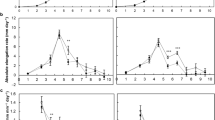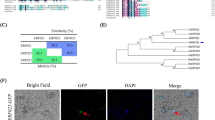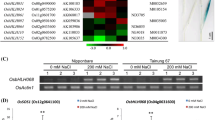Abstract
Temperature fluctuation profoundly affects the plant growth and development. In this study, we show that ethylene receptor ETR1 is involved in regulating leaf petiole elongation mediated by higher temperatures (at 32 °C in this study). ETR1 loss-of-function mutant etr1-7 cannot elongate the leaf petiole at 32 °C as much as wild-type seedlings (WT). Overexpression of ETR1 in etr1-7 not only fully rescued the deficient in petiole elongation under higher temperature conditions but also caused longer petiole length under normal temperature conditions (22 °C). Plants with different mutant ETR1 alleles including etr1-7 etr1-1, and etr1-9 but not etr1-3 impair the petiole elongation mediated by elevated temperature. RNA-Seq analysis showed that hundreds of genes induced by elevated temperature in WT were not differentially expressed in etr1-7. Gene ontology enrichment analysis reveals that the molecular functions of these genes primarily relate to photosynthesis and protein degradation. Furthermore, genes involved in regulating organ elongation (such as BRI1-EMS-SUPPRESSOR 1, BES1), are significantly up-regulated in WT rather than in etr1-7 after the treatment of higher temperature. The results from this study suggest ETR1 is involved in regulating Arabidopsis response to elevated ambient temperature in both molecular and morphological levels.





Similar content being viewed by others
References
Andrews S (2014) FastQC a quality control tool for high throughput sequence data. http://www.bioinformatics.babraham.ac.uk/projects/fastqc/
Bita CE, Gerats T (2013) Plant tolerance to high temperature in a changing environment: scientific fundamentals and production of heat stress-tolerant crops. Front Plant Sci 4:273
Chaiwanon J, Wang W, Zhu JY, Oh E, Wang ZY (2016) Information integration and communication in plant growth regulation. Cell 164(6):1257–1268
Chang C, Kwok SF, Bleecker AB (1993) Arabidopsis ethylene-response gene ETR1: similarity of product to two-component regulators. Science 262(5133):539–544
Chen YF, Randlett MD, Findell JL, Schaller GE (2002) Localization of the ethylene receptor ETR1 to the endoplasmic reticulum of Arabidopsis. J Biol Chem 277:19861–19866
Chen YF, Gao Z, Kerris RJI III, Wang WY, Bingder BM, Schaller GE (2010) Ethylene receptors function as components of high-molecular-mass protein complexes in Arabidopsis. PLoS ONE 5(1):e8640
Clough SJ, Bent AF (1998) Floral dip: a simplified method for Agrobacterium-mediated transformation of Arabidopsis thaliana. Plant J 16(6):735–743
Cox MP, Peterson DA, Biggs PJ (2010) SolexaQA: at-a-glance quality assessment of Illumina second-generation sequencing data. BMC Bioinform 11(1):485
Desikan R, Hancock JT, Bright J, Harrison J, Weir I, Hooley R, Neill SJ (2005) A role for ETR1 in hydrogen peroxide signaling in stomatal guard cells. Plant Physiol 137(3):831–834
Ge M, Liu Y, Jiang L, Wang Y, Lv Y, Zhou L, Liang S, Bao H, Zhao H (2018) Genome-wide analysis of maize NLP transcription factor family revealed the roles in nitrogen response. Plant Growth Regul 84(1):95–105
Hall AE, Chen QG, Findell JL, Schaller GE, Bleecker AB (1999) The relationship between ethylene binding and dominant insensitivity conferred by mutant forms of the ETR1 ethylene receptor. Plant Physiol 121(1):291–300
Hua J (2009) From freezing to scorching, transcriptional responses to temperature variations in plants. Curr Opin Plant Biol 12(5):568–573
Hua J, Meyerowitz EM (1998) Ethylene responses are negatively regulated by a receptor gene family in. Arabidopsis thaliana. Cell 94(2):261–271
Hua J, Sakai H, Nourizadeh S, Chen QG, Bleecker AB, Ecker JR, Elliot MM (1998) EIN4 and ERS2 are members of the putative ethylene receptor gene family in Arabidopsis. Plant Cell 10(8):1321
Jiang J, Zhang C, Wang X (2015) A recently evolved isoform of the transcription factor BES1 promotes brassinosteroid signaling and development in Arabidopsis thaliana. Plant Cell 27(2):361
Kim K, Portis AR Jr (2005) Temperature dependence of photosynthesis in Arabidopsis plants with modifications in Rubisco activase and membrane fluidity. Plant Cell Physiol 46(3):522–530
Kohorn BD, Kobayashi M, Johansen S, Riese J, Huang LF, Koch K, Fu S, Dotson A, Byers N (2006) An Arabidopsis cell wall-associated kinase required for invertase activity and cell growth. Plant J 46(2):307–316
Koini MA, Alvey L, Allen T, Tilley CA, Harberd NP, Whitelam GC, Franklin KA (2009) High temperature-mediated adaptations in plant architecture require the bHLH transcription factor PIF4. Curr Biol 19(5):408–413
Kotak S, Larkindale J, Lee U, Koskull-Döring PV, Vierling E, Scharf KD (2007) Complexity of the heat stress response in plants sachin. Curr Opin Plant Biol 10(3):310–316
Larkindale J, Knight MR (2002) Protection against heat stress-induced oxidative damage in Arabidopsis involves calcium, abscisic acid, ethylene, and salicylic acid. Plant Physiol 128(2):682–695
Larkindale J, Vierling E (2008) Core genome responses involved in acclimation to high temperature. Plant Physiol 146(2):748
Larkindale J, Hall JD, Knight MR, Vierling E (2005) Heat stress phenotypes of Arabidopsis mutants implicate multiple signaling pathways in the acquisition of thermotolerance. Plant Physiol 138(2):882–897
Lee SY, Hwang EY, Seok HY, Tarte VN, Jeong MS, Jang SB, Moon YH (2015) Arabidopsis AtERF71/HRE2 functions as transcriptional activator via cis-acting GCC box or DRE/CRT element and is involved in root development through regulation of root cell expansion. Plant Cell Rep 34(2):223–231
Lesk C, Rowhani P, Ramankutty N (2016) Influence of extreme weather disasters on global crop production. Nature 529(7584):84
Livak KJ, Schmittgen TD (2001) Analysis of relative gene expression data using real-time quantitative PCR and the 2(-delta delta C(T)) method. Methods 25(4):402–408
Lobell DB, Asner GP (2003) Climate and management contributions to recent trends in US agricultural yields. Science 299(5609):1032–1032
Meng L, Buchanan BB, Feldman LJ, Luan S (2012) CLE-like (CLEL) peptides control the pattern of root growth and lateral root development in Arabidopsis. Proc Natl Acad Sci 109(5):1760
Monfared MM, Simon MK, Robert J. Meister, Roig-Villanova I, Maarten Kooiker, Colombo L, Fletcher JC, Gasser CS (2011) Overlapping and antagonistic activities of basic pentacysteine, genes affect a range of developmental processes in Arabidopsis. Plant J 66(6):1020–1031
Park HY, Seok HY, Woo DH, Lee SY, Tarte VN, Lee EH, Lee CH, Moon YH (2011) AtERF71/HRE2 transcription factor mediates osmotic stress response as well as hypoxia response in Arabidopsis. Biochem Biophys Res Commun 414(1):135–141
Porter JR (2005) Rising temperatures are likely to reduce crop yields. Nature 436(7048):174–174
Qu X, Schaller GE (2004) Requirement of the histidine kinase domain for signal transduction by the ethylene receptor ETR1. Plant Physiol 136(2):2961–2970
Qu X, Hall BP, Gao Z, Schaller GE (2007) A strong constitutive ethylene-response phenotype conferred on Arabidopsis plants containing null mutations in the ethylene receptors ETR1 and ERS1. BMC Plant Biol 7(1):3
Sakai H, Hua J, Chen QG, Chang C, Medrano LJ, Bleecker AB, Meyerowitz EM (1998) ETR2 is an ETR1-like gene involved in ethylene signaling in Arabidopsis. Proc Natl Acad Sci USA 95(10):5812–5817
Shakeel SN, Wang X, Binder BM, Schaller GE (2013) Mechanisms of signal transduction by ethylene: overlapping and non-overlapping signalling roles in a receptor family. AoB Plants 5:plt010
Swindell WR, Huebner M, Weber AP (2007) Transcriptional profiling of Arabidopsis heat shock proteins and transcription factors reveals extensive overlap between heat and non-heat stress response pathways. BMC Genom 8(1):125
Vierstra RD (1996) Proteolysis in plants: mechanisms and functions. Post-transcriptional control of gene expression in plants. Springer, Amsterdam
Wang W, Hall AE, O’Malley R, Bleecker AB (2003) Canonical histidine kinase activity of the transmitter domain of the etr1 ethylene receptor from arabidopsis is not required for signal transmission. Proc Natl Acad Sci USA 100(1):352–357
Wang H, Zhu YY, Fujioka S, Asami T, Li JY, Li JM (2009) Regulation of Arabidopsis brassinosteroid signaling by atypical basic helix-loop-helix proteins. Plant Cell 21(12):3781–3791
Wang Y, Chen R, Hao Y, Liu H, Song S, Sun G (2017) Transcriptome analysis reveals differentially expressed genes (DEGs) related to lettuce (Lactuca sativa) treated by TiO2/ZnO nanoparticles. Plant Growth Regul 83(1):13–25
Zhang LY, Bai MY, Wu J, Zhu JY, Wang H, Zhang Z, Wang W, Sun Y, Zhao J, Sun X (2009) Antagonistic HLH/bHLH transcription factors mediate brassinosteroid regulation of cell elongation and plant development in rice and Arabidopsis. Plant Cell 21(12):3767–3780
Acknowledgements
We thank E. Schaller (Dartmouth College, Hanover, NH) for the ETR1 full-length construct. Funding for this study was provided by the National Natural Science Foundation of China (31400248), the Jiangsu Science Fund for Distinguished Young Scholars, China (BK20150027), Natural Science Foundation of Jiangsu Province (Grant No. BK20160584), and the China State Key Laboratory of Plant Physiology and Biochemistry (Grant No. SKLPPBKF1507).
Author information
Authors and Affiliations
Corresponding author
Electronic supplementary material
Below is the link to the electronic supplementary material.
Rights and permissions
About this article
Cite this article
Wang, Y., He, B., Ning, L. et al. A role of ETR1 in regulating leaf petiole elongation mediated by elevated temperature in Arabidopsis. Plant Growth Regul 86, 311–321 (2018). https://doi.org/10.1007/s10725-018-0430-4
Received:
Accepted:
Published:
Issue Date:
DOI: https://doi.org/10.1007/s10725-018-0430-4




